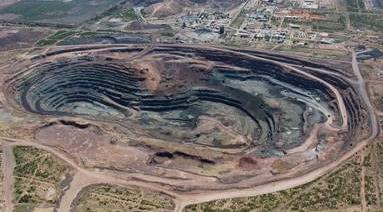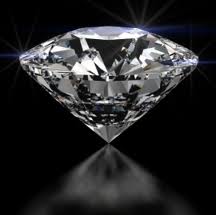The Jwaneng diamond mine is located about 100km west of Gaborone, the capital of Botswana, or about 160km by road. The name "Jwaneng" means "a place of small stones", an almost misleading name, considering this mine is the richest diamond mine in the world.
 The diamond potential of the site was discovered by prospectors working for the De Beers Diamond Company in 1972. The mine opened on the 14th of August 1982 and is operated by Debswana Diamond Company Ltd, a 50/50 partnership between De Beers and the Government of Botswana.
The diamond potential of the site was discovered by prospectors working for the De Beers Diamond Company in 1972. The mine opened on the 14th of August 1982 and is operated by Debswana Diamond Company Ltd, a 50/50 partnership between De Beers and the Government of Botswana.
In Botswana, the revenue from diamond mining contributes 50% of public revenue, 33% of the GDP and 70% of foreign exchange earnings. Jwaneng Mine itself contributes 60 - 70% of Debswana’s total earnings, approximately 50% of all foreign exchange earnings of the country.
While production varies each year, due to increases and decreases in demand, the mine yields around 141 carats per hundred tons of ore. In 2009, an exceptionally low production year due to the world financial crisis, the mine yielded 9.04 million carats from 6.06 million tons of treated ore. Production normally varies according to mining plans of approximately 12.5 to 15 million carats per year. In 2010, Jwaneng produced 11.5 million saleable carats. Typically for every ton of ore treated there is another 4 to 9 tons of waste rock.
The mining operation at Jwaneng is currently (2012) at a depth of 350 metres, but is expected to reach 624 metres by 2017. In 2010, Debswana initiated an expansion to the mine, termed "Cut 8", that would extend the life of the mine by at least 7 years, to at least 2024 and yield upwards of an additional 100 million carats. Future plans thereafter include deepening the mine to 850 metres extending the life of the mine by 20+ years.
Diamonds (the natural kind) are extremely old. The youngest diamonds are at least 900 million years old - formed long before dinosaurs roamed the planet.
Diamonds are made of carbon, an  element found in all organic matter and the main constituent, for example, of charcoal. Obviously there is a huge difference between diamond and charcoal - diamonds owe their unique properties of hardness and beauty to their strong and rigid molecular structure.
element found in all organic matter and the main constituent, for example, of charcoal. Obviously there is a huge difference between diamond and charcoal - diamonds owe their unique properties of hardness and beauty to their strong and rigid molecular structure.
Diamond has remarkable optical characteristics. Because of its extremely rigid lattice, it can be contaminated by very few types of impurities, such as boron and nitrogen. Combined with wide transparency, this results in the clear, colorless appearance of most natural diamonds. Small amounts of defects or impurities (about one per million of lattice atoms) color diamond blue (boron), yellow (nitrogen), brown (lattice defects), green (radiation exposure), purple, pink, orange or red.
Diamond also has relatively high optical dispersion (ability to disperse light of different colors), which results in its characteristic luster. Excellent optical and mechanical properties, combined with efficient marketing, make diamond the most popular gemstone.
The open pit Jwaneng mine sits above 3 kimberlite pipes - diamond producing geological formations - that converge just below the ground level. The mine covers all three of these tubes, approximately 54 hectares at ground level. In 2004, a fourth pipe was discovered by the mining operation. Kimberlite pipes act as an elevator bringing the diamonds and diamond ore from deep within the earth, where they have formed, close to the surface where they can be mined.
 The diagram to the right shows how a kimberlite pipe works.
The diagram to the right shows how a kimberlite pipe works.
At Jwaneng, the kimberlite has intruded shales of the Transvaal Supergroup around 240-250 million years ago. This makes it some of the oldest kimberlite in southern Africa. At that time, the surface of the ground was much higher than it is today, perhaps more than a km above it's current position, and over time it has eroded down to its current level, which explains why no outward appearance of volcanic activity remains.
Kimberlite is formed at depths of between 150 and 450 km, deeper than most other igneous rock types. The kimberlitic magma erupts rapidly and violently, often with considerable carbon dioxide and other volatile components. It is the extreme depth that kimberlite originates from which is the reason it is prone to hosting diamond xenocrysts.
The morphology of kimberlite pipes, and the classical carrot shape, is the result of explosive diatreme volcanism from very deep mantle-derived sources. These volcanic explosions produce vertical columns of rock that rise from deep magma reservoirs.
The morphology of kimberlite pipes is varied but generally includes a sheeted dyke complex of tabular, vertically dipping feeder dykes in the root of the pipe which extends down to the mantle. Within 1.5-2 km of the surface, the highly pressured magma explodes upwards and expands to form a conical to cylindrical diatreme, which erupts to the surface. The surface expression is rarely preserved, but is usually similar to a maar volcano. The diameter of a kimberlite pipe at the surface is typically a few hundred meters to a kilometer.
The published coordinates will take you to the main entrance to the Jwaneng mine. It is possible, with prior arrangement, to join an organised tour of the mine, but it is not a requirement of this earthcache to do so.
To claim a find on this earthcache, please complete the tasks outlined below. Answers to the questions should be emailed to the cache owner and not mentioned in your online log.
1. Describe the landscape surrounding the Jwaneng Mine including the colour of the rocky soil - what type of rock is it made of?
2. How is kimberlite formed and what kind of rock is it (sedimentary, igneous or metamorphic)?
3. What are those hills that you can see to the north of the mine?
4. (Optional) Take a photo of yourself and/or your GPS with the entrance of the mine or some of the mine buildings in the background and upload this with your online log.
You can log this cache straight away after you have emailed your answers to the cache owner, no need to wait for confirmation. Please include the name of this earthcache in the email - you'd be surprised how many people forget. Also, when contacting us with answers, if you want a reply, please include your email address. Any problems with your answers we'll be in touch.
 |
Google Mama |
References
http://gisr07.hubpages.com/hub/Jwaneng-Diamond-MineThe-Richest-Diamond-Mine-in-the-World
http://earthobservatory.nasa.gov/IOTD/view.php?id=35585
http://www.mining-technology.com/projects/debswana/
http://rough-polished.com/en/expertise/66191.html
http://wikimapia.org/13449265/Jwaneng-Diamond-Mine
http://www.sciencedirect.com/science/article/pii/S037702730700443X
http://www.debswana.com/Operations/Pages/Jwaneng.aspx
http://en.wikipedia.org/wiki/Jwaneng_diamond_mine
http://en.wikipedia.org/wiki/Kimberlite